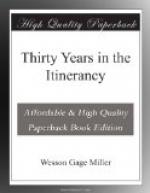Green Bay was made a United States trading port in 1815, with Col. John Bowyer as Indian Agent. And on the 16th of July of the following year, Col. John Miller commenced the erection of Fort Howard. The first frame house built, and perhaps the first in the State, was erected in 1825, by Col. E. Childs.
Col. Samuel Ryan came to Green Bay in 1826 and was the first Methodist, as far as I have been able to ascertain, who settled within the bounds of the Wisconsin Conference, and was probably the first in the State. From the time of his arrival until 1833, the religious Meetings were held in the Garrison school house and in an old Commissary store. Thereafter, and until a Church was erected, the services were held in a new yellow school house, or in the Garrison building at Fort Howard.
At the General Conference, which was held in Philadelphia in 1832, action was taken looking to the extension of the Missionary work of the Church in the Northwest. In furtherance of this object, Rev. John Clark, then of the New York Conference, was sent out as Superintendent of the work. This eminent Minister and able administrator, whose special record I need not enter in these pages, as his Life has been published, arrived at Green Bay July 21st, 1832. Immediately after his arrival he began his labors, preaching the first Methodist sermon within the limits of the present boundaries of the Wisconsin Conference. The sermon was delivered in the Fort, to both soldiers and citizens.
The first class was formed by Brother Clark immediately after, the services being held also in the Fort. This class consisted of four members, as follows: Col. Samuel Ryan, Sen., Mrs. Sherman, Mrs. Gen. Brooke, and a young man whose name cannot be given. Mrs. Brooke was the wife of the Commandant of the Fort, and Col. Ryan was the Leader.
Col. Ryan was born in Ireland, May 22d, 1789, and in early youth entered upon the military profession. He was in the engagement between the Shannon and Chesapeake off Boston Harbor, fought June 1st, 1813, and during the conflict was severely wounded. He was converted at Sackett’s Harbor, N.Y., under the ministry of Rev. Mr. Irwin, in 1821. In 1822 and ’23, he resided at Sault St. Marie, and while there was Leader of a class. During the year there was no Minister at the Sault, but Brother Ryan held religious services regularly among the soldiers, and as the fruit of his labors, seventy souls were converted. On coming to Green Bay, as above stated, in 1826, he resumed his labors, and continued to devote himself to the good work in that locality for twenty-six years. The Land Office, in which he held the first place, being now, 1852, removed to Menasha, he also took up his residence in that village.
Brother Ryan was a man of ardent temperament, full of vivacity, and not a little eccentric, but a true soldier of the Lord Jesus Christ. As in his youth his dauntless spirit never cowered in the presence of an earthly foe, so, in maturer years, he was a fearless champion for the spiritual reign of the Master. Honored by all, the Patriarch is now, “leaning upon the top of his staff,” with his dimned eye looking across the river, ready to move on at any moment.




